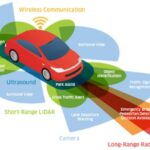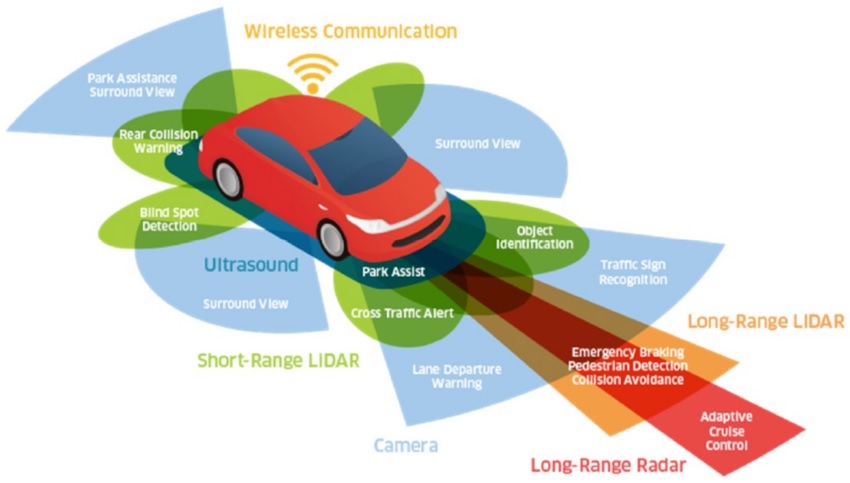Slide 1. Introduction.
The class develops the electromagnetic fields of electric vehicles, whether they have an impact on the health of vehicle users, and the implications for fleet management.
Slide 2. The electromagnetic fields of electric vehicles.
- Electromagnetic fields-EMFs.
The propagation of energy in the form of electromagnetic waves is known as electromagnetic radiation. Most EMFs are invisible to the human eye, although some are visible, such as rainbows.
Some examples of devices that produce electromagnetic fields are medium and high voltage power lines, electrical transformers, household appliances such as refrigerators and hair dryers, computer screens, anti-theft and security devices, radios, televisions, cell phone antennas, cell phones and cordless phones, microwave ovens, Wi-Fi, and Bluetooth.
All forms of radiant energy in the universe are known as the electromagnetic spectrum. This spectrum is divided into regions with different properties depending on the frequency, wavelength, and energy of the radiation.
Radiation is classified by frequency into.
- Ionizing radiation.
This is very dangerous because it can cause molecular changes due to the large amount of energy stored in its waves. It is the most harmful and causes the most adverse health effects, such as X-rays or ultraviolet rays.
- Non-ionizing radiation.
This has less energy and cannot alter matter. It includes radio frequencies, microwaves, and infrared rays. It produces thermal effects and encompasses electric and magnetic fields, such as Wi-Fi or the electrical grid.
EMF exposure levels are regulated by standards based on the recommendations of expert committees to protect the population.
- The relationship between electromagnetic fields and disease.
In 2002, the World Health Organization (WHO) published a report on the effects of electric and magnetic fields on the human body. The study noted that “there was little experimental or theoretical evidence that mutations could be caused directly by extremely low frequency magnetic fields” and concluded that “there is little evidence that extremely low frequency electric or magnetic fields can cause malignant transformation of cells in culture.” It also found that “static electric and magnetic fields and extremely low frequency electric fields are not classifiable as carcinogenic to humans.”
Despite these conclusions, the idea that such electric and magnetic fields may pose potential health problems remained, without being definitively discredited or confirmed.
The relationship between electromagnetic fields (EMFs) and disease is a subject of debate: studies on exposure to low-intensity EMFs have found no conclusive evidence that they cause negative health effects, such as cancer or symptoms like fatigue or headaches. However, some research suggests a possible increased risk of childhood leukemia and other ailments. On the other hand, some people report symptoms such as fatigue, headaches, or sleep problems, which they attribute to EMF exposure. This phenomenon is known as electromagnetic hypersensitivity, but science has not been able to establish a conclusive causal relationship.
While many studies conclude that there are no adverse health effects from acceptable levels of exposure to electromagnetic fields, others conclude that prolonged exposure to high levels of these fields may have negative health effects. When fields are very intense, they can alter blood flow or modify normal nerve impulses.
The health effects reported by some people are as follows.
- Electromagnetic hypersensitivity.
This is a set of symptoms that some people attribute to exposure to electromagnetic fields, such as headaches, fatigue, anxiety, nausea, palpitations, and sleep problems.
- Physical symptoms.
Redness, tingling, or burning of the skin.
- Neurasthenic symptoms.
Difficulty concentrating, dizziness, and fatigue.
- Other symptoms.
Sleep disorders, itchy skin, muscle pain, and irritability.
Although the symptoms of electromagnetic hypersensitivity are real for those who experience them, there is no conclusive scientific evidence to prove a direct link to exposure to electromagnetic fields.
- Scientific evidence on long-term effects.
- Cancer.
Overall, the evidence is inconclusive, although some studies suggest a possible increased risk of childhood leukemia in cases of high exposure.
Studies on other types of cancer, such as brain tumors, have yielded inconsistent results, and most have found no clear association.
-
- Cardiovascular disease.
Some research has suggested possible effects on heart rate, but the evidence of association is weak, and these findings have not been consistently replicated.
-
- Other symptoms.
Most symptoms attributed to EMF exposure, such as headaches or dizziness, have not been conclusively linked to exposure to electromagnetic fields below established safety limits.
- When and where electromagnetic fields are generated in cars.
Electromagnetic fields are generated wherever electricity flows. In vehicles, they affect both the drive system and electrical components such as seat heating and air conditioning. In electric cars, they occur especially when high currents are flowing, for example during acceleration or intense regenerative braking.
Measurements showed that the highest values were generally recorded in the foot and lower leg area, where wiring and electrical components are typically located. The head and chest area was affected to a lesser extent. High values were also recorded for a short period of time when the vehicle was started, regardless of whether it was electric or combustion.
Electric cars generate low-intensity, non-ionizing electromagnetic fields (EMFs), which are not considered dangerous.
The sources of electromagnetic fields are.
-
- Battery and electric motor.
The high-voltage battery and motor generate EMF, which is more intense during acceleration or regenerative braking.
-
- Wiring.
The vehicle's wiring is a source of EMF.
-
- Charging process.
Charging, especially with high-power chargers, generates more intense radiation peaks, although these are localized and short-lived.
-
- Electronic systems.
Electronic components, sensors, heating and air conditioning systems also emit electromagnetic fields.
- Scope and methodology of the study.
The German Research Center for Electromagnetic Environmental Compatibility, together with Seibersdorf Labor GmbH and in cooperation with ADAC, Europe's largest automobile association, has conducted research to determine whether electric cars expose occupants to electromagnetic fields.
After taking more than 975,000 measurements on test benches, test tracks, and in traffic, the researchers came to a conclusion: none of the measurements showed that the applicable limit values were exceeded. According to the researchers' calculations, people with implants or pregnant women are also not exposed to any of these dangers when traveling in electric vehicles. It's that clear-cut.
In this study, a total of fourteen different vehicles were examined in Germany: eleven battery electric vehicles (BEVs), two plug-in hybrid electric vehicles (PHEVs), and one internal combustion engine vehicle for comparison purposes. The researchers measured the magnetic fields at various positions in the seats, from the footwell to head height. To do this, they used highly sensitive measuring probes that continuously recorded data while driving and under normal loading conditions, such as acceleration, braking, and regenerative braking.
In addition, the scientists simulated the propagation of the fields through the human body using anatomical models. These calculations also showed that exposure remained well below the basic limits set by the International Commission on Non-Ionizing Radiation Protection (ICNIRP).
- Results for the 14 vehicles tested.
In the vehicles tested, the maximum exposure index measured (ExpInd) was evaluated based on the reference values of the International Commission on Non-Ionizing Radiation Protection. A value of 1.0 would reach the limit, and none of the vehicles tested exceeded this value, all falling well below it, confirming that there is no health risk today.
The analysis also clearly shows that electric cars do not differ from combustion engine vehicles in terms of electromagnetic exposure. Short-term peaks during acceleration or braking remain well below the permitted limits. In fact, driving style is found to be more important than engine power, as those who drive smoothly generate very weak magnetic fields.
Other electrical systems, such as seat heating or on-board electronics, can also generate measurable fields for short periods. However, these are always well below the established reference values and, according to experts, pose no health risk.
However, although this test appears conclusive, it does not mean that research into the effects of EMF fields on the human body should be discontinued. Above all, because we know that we are surrounded by sources of magnetic fields of varying intensities and that the most powerful ones are linked to cellular changes.
- Comparison with trains, trams, and buses.
Researchers also took measurements on trains, trams, and subways. These measurements showed that average exposure is comparable to or slightly higher than that of electric cars, especially near traction motors or power lines. Electromagnetic pollution is therefore not a phenomenon exclusive to electric cars, but an inherent feature of any electric vehicle or means of transport.
Although it does not pose a danger to vehicle occupants, the authors recommend paying greater attention to electromagnetic compatibility in future development. Manufacturers can further reduce field strength by strategically locating high-voltage lines or inverter modules. The researchers also call for a review of the European test standard EN IEC 62764-1, as it does not currently take short magnetic peaks fully into account.
- The SINTEF study.
In 2014, SINTEF, an independent research organization based in Norway, published a new study whose conclusions were summed up in the title: “No danger from magnetic fields in electric cars.” The research that led them to this conclusion was funded entirely by the European Union and claimed to be “the most comprehensive study to date to identify the different sources of magnetic fields in electric cars.”
As the title suggests, the conclusion is that “there is absolutely no cause for concern.” The difference between this research and previous similar studies is that “we have taken into account what contributes to magnetic fields. The rotation of the wheels generates considerable magnetic fields, regardless of the type of vehicle.”
To verify the actual effects of each technology, seven different electric vehicles were tested, along with a gasoline-powered car and another powered by a hydrogen fuel cell. In electric vehicles, the strongest magnetic fields were recorded near the ground, where the batteries are located. Their strength decreased almost tenfold when measured at head height.
One conclusion that may come as a surprise to most is that there are no major differences between electric vehicles and gasoline or diesel vehicles. The researchers argue that this indicates that all cars, regardless of their energy source, generate magnetic fields. Although these are slightly higher in electric vehicles, they are not high enough to pose a risk to their occupants.
Furthermore, with the exception of convertibles, the bodywork of cars helps to concentrate the magnetic field around the vehicle. It was also found that electric vehicle batteries emit a stronger field when the vehicle starts up, when there is high demand on the battery, i.e., during rapid acceleration, or when charging.
- Implications for fleet management.
The main consequence is that, according to previous studies, there is no risk to the health of drivers and users of electric vehicles caused by their electromagnetic fields.
The following measures are recommended.
-
- Multiple sources of electromagnetic fields.
While a single source may not be cause for concern, exposure to multiple sources acting at the same time may have a more pronounced effect.
For example, taking a short trip in an electric vehicle every day may not be particularly harmful, but the case is different for a professional driver, such as a taxi driver, who spends most of the day in one of these vehicles, surrounded by devices that generate radiofrequency radiation.
If we have doubts about whether our electric vehicle is within the permitted limits, we can measure the electromagnetic fields with an electromagnetic field meter, a device that detects and measures the intensity of electric and/or magnetic fields. These devices can be professional or simpler and are used to identify the presence of radiation and its magnitude in different locations.
It is recommended that a certified laboratory perform the measurement and issue a report on the electromagnetic fields of our electric vehicle, whether they are within the permitted limits, and the measures to be taken.
An electromagnetic field meter can be purchased to control and monitor the electric vehicles in the fleet.
-
- Driver training.
Drivers must be trained on what electromagnetic fields are, which ones they are exposed to in electric vehicles, and other devices they may use, in addition to showing them the external laboratory report.
-
- Monitoring and tracking driver health.
At least one annual health check should be carried out on the driver to detect any possible illnesses or ailments caused by the electromagnetic fields of the electric vehicle. In many countries, it is mandatory to carry out an annual medical examination, the results of which are given to the worker.
The driver should be asked from time to time if they have headaches, discomfort, fatigue, etc. It is recommended to use an online or printed questionnaire.
-
- Driving style.
A sporty driving style, with heavy acceleration and braking, generates significantly stronger magnetic fields than a moderate driving style.
Drivers should be trained to drive smoothly, without sudden acceleration or braking, to avoid high electromagnetic fields, even if they are short-lived.
-
- Characteristics of electric vehicles.
Before purchasing an electric vehicle, it is important to know where the sources of electromagnetic fields are located.
The further away the sources of strong magnetic fields are from the vehicle occupants, the lower the fields to which the occupants will be exposed under different driving conditions.
-
- Electromagnetic field standards and regulations.
Electric vehicles and charging points must be purchased that comply with the most stringent standards and regulations regarding electromagnetic fields.
Regulations on electromagnetic fields in electric vehicles focus mainly on the safety of charging facilities, which are regulated by the international standard IEC 61851-1.
Although vehicles generate low-frequency radiation, the levels are usually low and regulations, such as Royal Decree 1066/2001 in Spain, establish limits for public exposure.
Slide 3. Thank you for your time.
The class has developed the electromagnetic fields of electric vehicles, whether they have an impact on the health of vehicle users, and the implications for fleet management, see you soon.
Download the audio




















